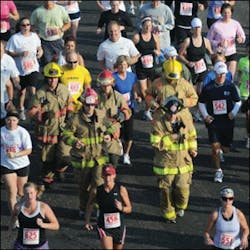Camaraderie in Fitness: Running a Marathon – Part 1
Running a marathon is the latest rage. So, you and your company want to be part of the one percent in world to have completed a marathon? That is 26.2 fun-filled and not easily forgotten miles! Actually, it is a more realistic goal than you might imagine. However, it does require disciplined training and adjusting your diet for 12 to 18 weeks so you and your company can cross the finish line as a team. So, why run a marathon? Well, obviously, bragging rights within your department. More importantly, however, the camaraderie that develops between individuals who train and compete together, the physical fitness benefits from the marathon training and diet, and lastly the personal sense of accomplishment the moment that you cross the finish line.
This article is aimed at the novice runner and is a general overview of training for a marathon. We have provided links at the end of the article to various training programs that both novice and advanced runners will find useful. With that being said, as a novice runner, you should be able to run three miles without stopping when you begin your company’s training. The key to success is completing a progressively longer run every weekend, ideally done as a company. Typically, starting around six miles on the first weekend and ultimately ending with a 20- to 22-mile long run two to three weeks prior to the race. During the rest of the week, you as an individual or company should be running three times a week with mileages that increase from three to 10, 12, 16, or more depending on the program selected. Also, one day during the week you should do some form of cross-training (swimming, cycling, weight training, etc.), which gives your body a break from running and much-needed rest. Rest is an often neglected component of most runners training programs. Rest leads to healing, recuperation, and repair of damaged muscle that occurs during training and is another key component to achieving your company’s goal. Nutrition is also a key component, which we will discuss more in-depth next month.
Since most marathon training programs consist of running from 300 to 500 miles over the course of the training, it stands to reason that your feet would appreciate you investing in a good pair of running shoes. Running shoes varying in price range, performance, and function (support, cushioning, stability, and motion-control). Most running stores have staff that can assist you in determining the appropriate type of shoe for you and also suggest a good quality running sock, which will prevent and/or minimize blisters from your long runs.
If you and your company are thinking of doing a marathon as a team, you must realize that there will be various levels of fitness and running abilities among the company members. To address these variables, some individuals may need to consider starting a pre-training program to bring everyone’s abilities to a similar level upon starting the official training program. This may include training from a few months prior to launching the 12- to 18-week program to up to a year prior and could include 5K, 10K, 10-mile races, and a half-marathon. All of these help prepare the individual and/or company for the challenges of training for a marathon. If you or your company does not have time to train for a marathon, a 5K, 10K, 10-mile races, or a half-marathon are good alternatives.
As we wrap up, we always recommend that you have a physical prior to any major dietary change or beginning a new workout regime. It is worth the cost. Don’t hesitate to contact us if your company decides to run a marathon. Next month, we will look at and discuss the role of nutrition in preparing for a marathon. Now’s the time for your company to start asking, “Do we want to run a marathon as a company in 2011?” Until February, stay safe!
SCOTT TOMEK MA, EMT-P has been a paramedic for 25 years with 23 of those at Lakeview Hospital EMS in Stillwater, MN. He is a faculty member with the Century College Paramedic Program and wrote the curriculum for and served as the interim director of their public safety degree program. He is a frequent contributor to EMS Magazine, a frequent presenter at EMS conferences in the Midwest and an educational consultant to fire and EMS services. He can be reached at [email protected]. NICOLE OLSON is an undergraduate student at Mankato State University where she is majoring in health science with a minor in psychology. Her areas of interest are childhood obesity, nutrition, and endurance sports. She is an accomplished sub-four hour marathoner. She can be reached at [email protected].
About the Author

Scott Tomek and Nicole Olson
Scott Tomek, MA, EMT-P has been a paramedic for 25 years with 23 of those at Lakeview Hospital EMS in Stillwater, Minnesota. He is a faculty member with the Century College Paramedic Program and wrote the curriculum for and served as the interim director of their Public Safety degree program. He is a frequent contributor to EMS Magazine, a frequent presenter at EMS conferences in the Mid-West, and an educational consultant to fire and EMS services. He can be reached at [email protected]
Nicole Olson is an undergraduate student at Mankato State University where she is majoring in Health Science with a minor in psychology. Her areas of interest are childhood obesity, nutrition, and endurance sports. She is an accomplished sub-4 hour marathoner. She can be reached at [email protected]
